Piaggio APE TM User Manual
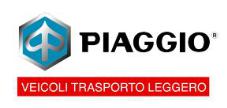
Piaggio would like to thank you
for choosing one of its products. We have drawn up this booklet to show you all features of our product. Please read the booklet carefully before using your vehicle. It includes information, suggestions and warnings regarding your vehicle. You will also be informed of features, details and devices that will prove the excellence of your choice. We believe that if you follow our suggestions you will soon tune in with your vehicle and use it for a long time at full satisfaction.
This booklet is an integral part of the vehicle, and upon sale, it should be transferred to the new owner.
Ape TM - Ape TM Diesel
Ed. 01_02/2012
INSTRUCTIONS
The instructions given in this booklet are intended to provide a clear, simple guide to using your scooter; details are also given of routine maintenance procedures and regular checks that should be carried out on the vehicle at an Authorised PIAGGIO Dealer or Service Centre. The booklet also contains instructions for simple repairs. Any operations not specifically described in this booklet require the use of special tools and/or particular technical knowledge: to carry out these operations refer to any authorised PIAGGIO Dealer of Service Centre. Read this booklet carefully before using your vehicle. Follow the instructions contained in this booklet for your personal safety and to ensure long-lasting use of your vehicle. Failure to observe these instructions may cause personal injury or damage to the vehicle.
2

Personal safety
Failure to completely observe these instructions will result in serious risk of personal injury.
Safeguarding the environment
Sections marked with this symbol indicate the correct use of the vehicle to prevent damaging the environment.
Vehicle intactness
The incomplete or non-observance of these regulations leads to the risk of serious damage to the vehicle and sometimes even the invalidity of the guarantee.
The signs indicated on this page are very important, they highlight the parts of the booklet that should be read with particular care. Each sign consists of a different graphic symbol, making it quick and easy to locate the various topics.
3
4
IDENTIFICATION......................................................................... |
7 |
Vehicle identification number.................................................... |
8 |
SAFE RIDING.............................................................................. |
11 |
Safe drive.................................................................................. |
12 |
Running-in period...................................................................... |
12 |
VEHICLE USE.............................................................................. |
13 |
Checks...................................................................................... |
14 |
Before starting the engine......................................................... |
18 |
Engine start up.......................................................................... |
19 |
Stopping the engine.................................................................. |
21 |
Starting difficulties..................................................................... |
21 |
Gear position............................................................................. |
22 |
Driving Tips............................................................................... |
23 |
DOORS AND LOCKS.................................................................. |
27 |
Keys.......................................................................................... |
28 |
Door locking/unlocking by key............................................... |
28 |
Front door windows................................................................... |
29 |
Engine inspection port.............................................................. |
30 |
SEATS AND SAFETY BELTS..................................................... |
31 |
Using the safety belts................................................................ |
32 |
Fasting the safety belt........................................................... |
33 |
Adjusting the safety belt........................................................ |
34 |
To release the safety belt...................................................... |
34 |
INSTRUMENT PANEL AND CONTROLS................................... |
35 |
Handlebars............................................................................ |
36 |
Steering wheel....................................................................... |
39 |
Controls..................................................................................... |
43 |
Ignition switch........................................................................... |
53 |
GAUGES AND WARNING LIGHTS............................................ |
55 |
Instrument unit and indicators................................................... |
56 |
AIR CONTROL SYSTEM............................................................. |
57 |
Heating.................................................................................. |
58 |
Heating and demisting........................................................... |
59 |
|
INDEX |
Demisting.............................................................................. |
59 |
MIRRORS AND WINDOW GLASSES......................................... |
61 |
Adjusting the mirror............................................................... |
62 |
Wipers and Brushes.................................................................. |
62 |
INSIDE EQUIPMENT................................................................... |
65 |
ELECTRICAL SYSTEM............................................................... |
67 |
Fuel version.............................................................................. |
68 |
Diesel version........................................................................... |
68 |
EMERGENCY.............................................................................. |
71 |
Wheel replacement................................................................... |
72 |
Maintenance instructions....................................................... |
72 |
MAINTENANCE........................................................................... |
75 |
Check engine oil level........................................................... |
76 |
Oil change and oil filter replacement..................................... |
76 |
Checking the brake fluid level................................................... |
79 |
Gear box oil level...................................................................... |
81 |
Window washer fluid level......................................................... |
83 |
Cooled fluid............................................................................... |
83 |
Changing the engine cooling fluid......................................... |
84 |
Checking and replacing the air cleaner element....................... |
84 |
Replacing the fuel filter............................................................. |
85 |
Air bleeding........................................................................... |
86 |
Fuel exhaustion..................................................................... |
86 |
Checking and replacing the pre-heating plugs.......................... |
87 |
Fuses........................................................................................ |
88 |
Exhaust circulation system (EGR)......................................... |
91 |
Tyres......................................................................................... |
91 |
Pressure................................................................................ |
92 |
Periods of inactivity................................................................... |
92 |
Troubleshooting / What to do if................................................. |
98 |
SPARE PARTS AND ACCESSORIES........................................ |
107 |
Warnings................................................................................... |
108 |
TIPPER VERSION....................................................................... |
109 |
5
System Operation..................................................................... |
110 |
Warnings for Loading and Unloading Operations..................... |
111 |
Scheduled Maintenance........................................................... |
114 |
Extraordinary Maintenance....................................................... |
116 |
Trouble-Shooting...................................................................... |
117 |
Warning Plate Symbols............................................................. |
120 |
technical sheet for EC conformity declaration........................... |
123 |
Preface.................................................................................. |
123 |
Equipment Layout................................................................. |
124 |
Analysis of Risks Connected with the Layout and Operation |
|
of the Equipment................................................................... |
127 |
TECHNICAL DATA...................................................................... |
135 |
Vehicle...................................................................................... |
138 |
SCHEDULED MAINTENANCE - CHECKS................................. |
149 |
Scheduled maintenance service............................................... |
150 |
6

Ape TM - Ape TM Diesel
Chap. 01
Identification
7
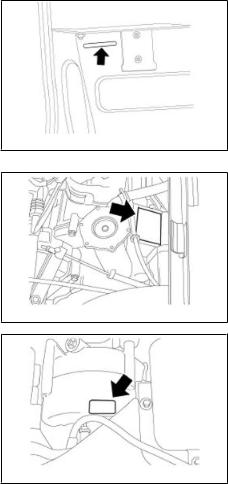
1 Identification
01_01
01_02
01_03
Vehicle identification number (01_01, 01_02, 01_03)
The identification codes consist of a prefix followed by a number punched on the chassis and on the engine, respectively.
Always quote the serial numbers when ordering spare parts.
The chassis identification number is located on the crossmember under the seat as shown in the figure.
The frame identification code is:
ZAPT1000000001001
Check that the chassis prefix and number punched on the vehicle correspond to that shown on the vehicle documents.
The engine identification number is printed as shown in the figure.
The first indicates the location of the plate on the diesel engine, while the second is on the gasoline engine.
The gasoline version engine identification initials are:
ATM2M
The diesel version engine identification initials are:
LDW 422
8

CAUTION
BE REMINDED THAT ALTERING IDENTIFICATION REGISTRATION NUMBERS MAY LEAD TO SERIOUS PENAL SANCTIONS (IMPOUNDING OF THE VEHICLE. ETC.)
Identification 1
9
1 Identification
10

Ape TM - Ape TM Diesel
Chap. 02
Safe riding
11
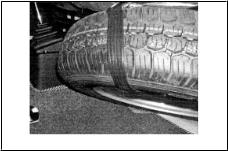
Safe drive (02_01)
ENSURE THE SPARE WHEEL IS CORRECTLY SECURED TO THE SEAT
THROUGH THE RETAINING STRAP, IN ORDER TO PREVENT IT FROM MOVING
IN THE EVENT OF AN EMERGENCY STOP.
02_01
Running-in period
During the first 1000 km, do not twist the throttle fully open and avoid driving at constant speed over long stretches of roads. After the first 1000 km gradually increase speed until reaching the maximum performance.
2 Safe riding
12

Ape TM - Ape TM Diesel
Chap. 03
Vehicle use
13

3 Vehicle use
Checks (03_01, 03_02, 03_03, 03_04)
Before using the vehicle, check:
1. That the oil and fuel (for fuel versions) tanks are filled.
2. The engine/transmission oil level (for diesel versions).
3. The brake fluid level.
4. That the tyre inflation pressure is correct.
5. Correct operation of side/taillights, headlights and turn indicators.
6. Front and rear brake operation.
7. Gearbox oil level (for petrol versions).
8. Electrolyte and battery charge check.
9. Check coolant (diesel version)
CAUTION
TYRE PRESSURE SHOULD BE CHECKED WHEN TYRES ARE COLD.
|
TYRE PRESSURE |
Front tyre pressure |
2.5 atm |
Rear tyre pressure |
4.5 atm |
|
|
Fuel tank
14

The fuel filler cap is fitted with a lock.
To open: insert the supplied key and turn it anticlockwise.
To close: put the filler cap back in position, turn the key clockwise and remove.
For petrol versions, the recommended fuel is as follows:
- unleaded petrol.
For diesel versions, the recommended fuel is as follows:
- diesel normally found on the market.
To this purpose please note that at low temperatures the paraffin elements contained in diesel spontaneously dissociate, thereby decreasing fluidity. If it is not possible to use winter type diesel, mix diesel with a special additive in the amounts indicated on the container.
The additive must be poured into the tank before the diesel and before the process described above since a late addition generates no effects.
CAUTION
∙ WHEN REFUELLING, KEEP THE CAP CLEAN FROM DUST AND DIRT.
CAUTION
BEFORE REFUELLING, STOP THE ENGINE. PETROL IS HIGHLY INFLAMMABLE. DO NOT DROP PETROL ON HOT ENGINE PARTS. DO NOT SMOKE. KEEP NAKED FLAMES AWAY: FIRE HAZARD. DO NOT INHALE PETROL FUMES.
use Vehicle 3
15
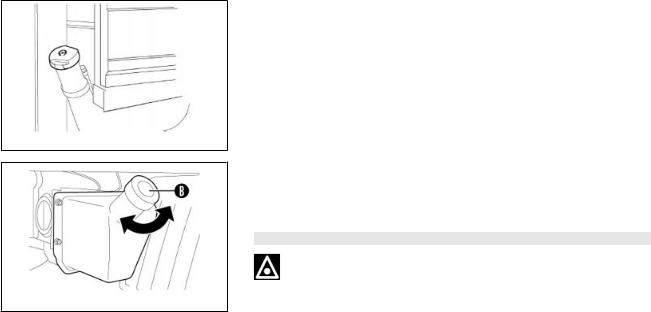
3 Vehicle use
|
FUEL |
Total capacity: |
15 litres |
Fuel |
(Unleaded petrol) |
|
|
03_01
Oil tank (for petrol versions)
The oil tank is provided with a light reserve indicator on the instrument panel.
To top up, remove cap «B» and pour in new oil.
CAUTION
USING OTHER TYPES OF OIL CAN COMPROMISE ENGINE DURABILITY.
03_02
Recommended products
AGIP CITY TEC 2T
Oil for 2-stroke petrol engines
JASO FC, ISO-L-EGD Specifications
16
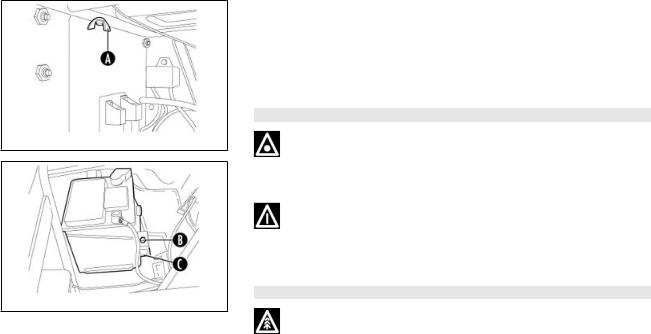
Characteristic
Mixer oil (2.0 l)
RESERVE: 0.6 l
Removing the battery
The battery is located under the seat. The latter can be easily tilted removing the two nuts «A» located at the two ends below the seat, as shown in the figure.
If it is necessary to remove the battery from its housing (for replacing or charging it), disconnect the cables, remove nut «B» and release the battery from the locking bracket «C».
CAUTION
03_03
NEVER DISCONNECT THE BATTERY WHEN THE ENGINE IS RUNNING TO AVOID DAMAGING THE ELECTRICAL SYSTEM.
BATTERY ELECTROLYTE CONTAINS SULPHURIC ACID: AVOID CONTACT WITH EYES, SKIN AND CLOTHES. IN THE EVENT OF ACCIDENTAL CONTACT, RINSE WITH PLENTY OF WATER AND SEEK MEDICAL ADVICE
WARNING
03_04
USED BATTERIES ARE HARMFUL FOR THE ENVIRONMENT AND MUST BE COLLECTED AND DISPOSED OF IN COMPLIANCE WITH THE LAW.
use Vehicle 3
17

3 Vehicle use
Installing a new battery
Make sure the terminals are fitted correctly. The battery is an electrical device that requires careful checks and diligent maintenance.
CAUTION
DO NOT INVERT THE POLARITIES: DANGER OF SHORT-CIRCUIT AND FAULTS IN THE ELECTRICAL DEVICES.
Checking electrolyte level
The electrolyte level must be checked frequently and must reach the maximum level.
Top up exclusively with distilled water.
If the battery requires topping up too frequently, check the electrical system - the battery is probably working in overload conditions, which will lead to rapid deterioration.
Before starting the engine
-Ensure that the parking brake is released.
-Ensure that the reverse gear control lever is forward or backward according to whether you want to move forward or in reverse.
-Ensure that the gear control lever is in neutral position: position N for the handlebar version, central lever position for the steering wheel version.
THIS PRELIMINARY OPERATION IS NOT REQUIRED IN THE STEERING WHEEL DIESEL VERSION.
18
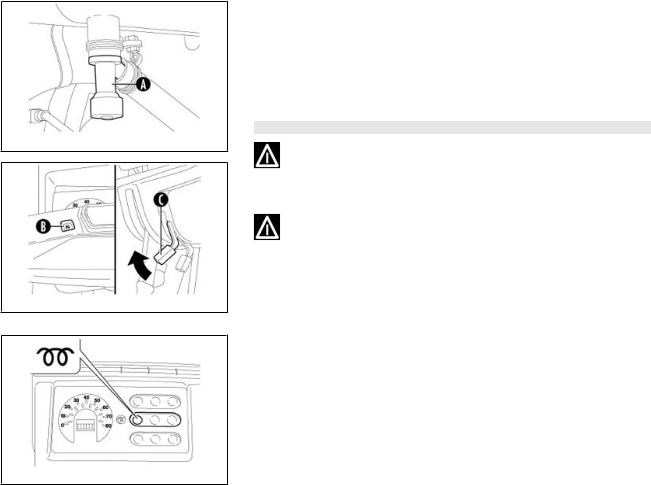
Engine start up (03_05, 03_06)
Engine ignition (gasoline version)
Open the fuel cock «A» (turn it counter clockwise to open and clockwise to close).
With cold engine, pull the starter lever «C» and insert the start key into the key switch, then turn it to position 2 and at the same time press the accelerator control.
After start up, release the key that will automatically return to position 1.
WARNING
03_05
EXHAUST GASES ARE TOXIC. DO NOT START THE ENGINE IN A CLOSED PLACE.
WHEN THE ENGINE IS ON, DO NOT HANDLE PARTS AND CONNECTIONS OF THE ELECTRIC SYSTEM, ESPECIALLY THE SPARK PLUG CABLE.
03_06
Engine start up (03_06, 03_07)
Engine ignition (diesel version)
Introduce the start key into the switch and move it to position 1. On the instrument panel, the glow plug preheat indicator will light up. The hotter the engine, the sooner the indicator will turn off. Then move the key to position 2 while pressing the accelerator control at the same time. After start up, release the key that will automatically return to position 1.
03_07
use Vehicle 3
19
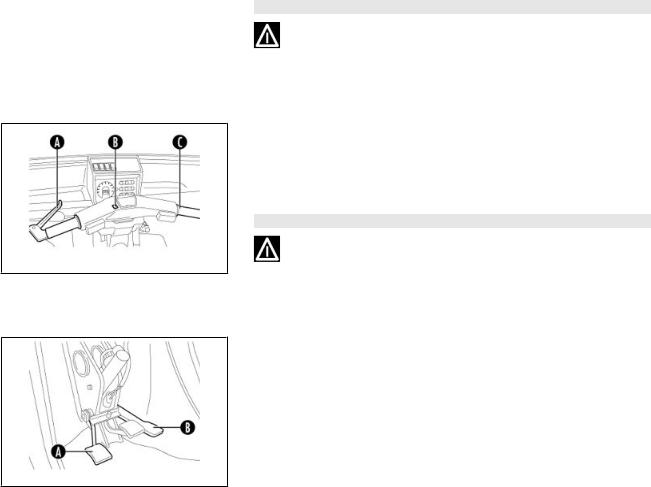
3 Vehicle use
WARNING
EXHAUST GASES ARE TOXIC. DO NOT START THE ENGINE IN A CLOSED PLACE.
Engine start up (03_07, 03_08)
Starting off (versions with handlebar)
With idle engine, pull the clutch lever «A» and turn the gear knob to the 1st gear (position 1 on the gear indicator «B »). To start off, release the clutch lever «A» smoothly and accelerate by turning the throttle twist grip «C».
WARNING
03_08
EXHAUST GASES ARE TOXIC. DO NOT START THE ENGINE IN A CLOSED PLACE.
Engine start up (03_08, 03_09)
Start-up (handlebar versions)
With idle engine, press the clutch pedal «A» and engage the first gear with the gearbox lever. Gently release the clutch pedal while gradually pressing the accelerator pedal «B».
03_09
20
Stopping the engine
Stopping the engine (handlebar)
Before stopping the engine, shift to neutral (position «N» on the gear indicator « B »).
Then turn the ignition key to «A».
Stopping the engine (steering wheel)
Before stopping the engine, move the gearbox to neutral (central position), then turn the switch key to position «A».
Starting difficulties
Engine starting difficulties (gasoline version)
Possible causes and suggested actions:
- Carburettor flooded.
Close the fuel cock, turn the start key to position "1"; with closed starter open the gas thoroughly and actuate the key switch, moving it to position "2"; open the fuel cock again and move the key switch to position "2". In any case, do not try starting for more than 5-6 times.
- Dynamotor or battery inefficiency.
Use an auxiliary battery with equivalent or slightly higher specifications with respect to the original battery.
If you need to bump start the vehicle (by pushing or towing), follow these instructions: engage a high gear (2nd or 3rd), do not exceed 20 kph (even when freewheeling), release the clutch pedal or lever gradually.
use Vehicle 3
21
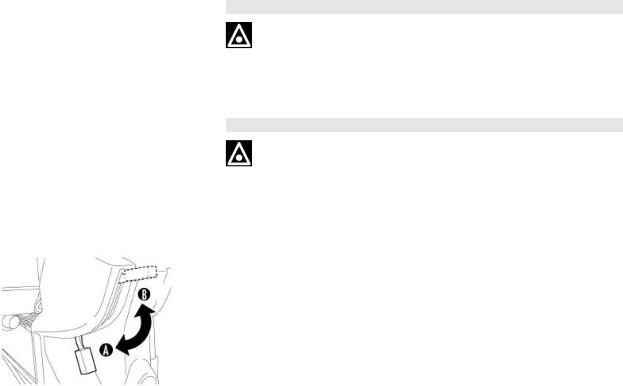
3 Vehicle use
Before performing this operation, check the reverse lever position. If you cannot start the engine even with the procedure described above, contact an Authorised PIAGGIO Service Centre.
CAUTION
NEVER STRESS THE ENGINE AT LOW TEMPERATURES IN ORDER TO AVOID
POSSIBLE DAMAGE. WHEN DRIVING DOWNHILL, DO NOT EXCEED TOP
SPEED OR THE ENGINE COULD BE DAMAGED BY PROLONGED OVERREV-
VING.
CAUTION
∙AFTER A LONG JOURNEY ALLOW THE ENGINE TO RUN AT IDLE SPEED FOR A FEW SECONDS BEFORE SWITCHING IT OFF.
|
Gear position (03_10, 03_11, 03_12) |
|
|
||
|
To reverse the vehicle, proceed as follows: |
|
|
1. Stop the vehicle completely and turn the gear selector to neutral (position «N» on |
|
|
the gear indicator «B») while the engine is idling; |
|
|
2. For gasoline versions, lift the reverse gear control lever from position «A» to position |
|
|
«B». |
|
|
3. Diesel versions are not equipped with a reverse gear control lever. |
|
03_10 |
4. Use the gear control lever to engage gears; («1stgear» for the gasoline version, |
|
«R» for the handlebar version), and gently release the clutch pedal while gradually |
||
|
||
|
pressing the accelerator pedal. |
22
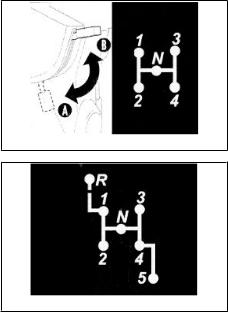
03_11
03_12
5. To shift from reverse gear to the forward gears repeat the previously described procedures and move the reverse gear control lever to the «A» position (in the gasoline version and in the handlebar version).
Note: in the diesel handlebar version, once the reverse gear control lever has been moved to the «B» position, both the reverse gear and the «1st gear» can be used for vehicle parking manoeuvring; engagement of higher gears remains disabled until the reverse gear control lever is set to the «A» position.
Driving Tips
Follow these simple recommendations to use your vehicle every day, confidently and safely.
Your ability and your mechanical knowledge form the basis of safe riding. Practice driving in a traffic-free area until you acquire a good knowledge of the vehicle.
1. Always drive within the limits of your ability, strictly following the road regulations of the country where you are driving.
use Vehicle 3
23

3 Vehicle use
2. Carefully adjust the position of rear-view mirrors, to easily check the road behind you.
3. Ensure nothing hinders the pedals stroke (mats, etc.)
4. Ensure that headlights are working properly.
5. To start the vehicle, with idle engine, engage the first gear and gently release the clutch lever, accelerating at the same time.
6. Reduce speed on badly surfaced roads and drive with caution.
7. Do not brake fully on wet, unsurfaced or slippery roads.
8. Do not shift down when the engine is running at high revs to avoid dangerous overrevving.
9. On a downhill, do not keep the gearbox to neutral position or the engine off, but decrease speed closing the accelerator. To facilitate the decrease of speed, use the brakes without pulling them for too long, to prevent dangerous overheating that would decrease their efficiency. Shift down to increase the engine brake effect.
10. For rapid pick-up, e.g. for overtaking, shift down a gear to employ all the required power.
11. When driving up demanding slopes, shift down to employ all the required power.
12. Check that the load is evenly distributed on the loading body, and do not exceed the provided loads (see chapter: "Technical data -performance") to prevent tilting while turning on a corner.
ALWAYS DRIVE YOUR VEHICLE WITHIN THE LIMITS OF YOUR ABILITY. DRIVING WHILE DRUNK OR UNDER THE EFFECT OF DRUGS OR CERTAIN MEDICINES IS EXTREMELY DANGEROUS AND INFRINGES THE ROAD REGULATIONS.
24

ANY CHANGES TO VEHICLE PERFORMANCE, AS WELL AS ALTERATIONS TO ORIGINAL STRUCTURE PARTS, RENDERS THE VEHICLE NO LONGER CONFORMING TO THE APPROVED TYPE AND THEREFORE DANGEROUS FOR DRIVING SAFELY.
use Vehicle 3
25
3 Vehicle use
26

Ape TM - Ape TM Diesel
Chap. 04
Doors and locks
27
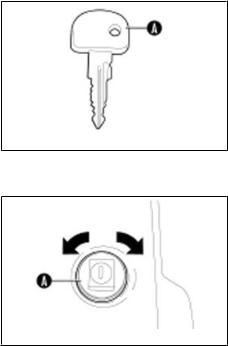
Keys (04_01)
The vehicle is supplied with two copies of the key.
«A»: key for the ignition and start-up switch, the door lock and the fuel tank cover.
The code numbers, in fact, are the only way to identify the key for future copies.
YOU SHOULD KEEP A DUPLICATED KEY AND ITS CORRESPONDING CODE IN
ANY PLACE OTHER THAN THE VEHICLE.
04_01
Door locking/unlocking by key (04_02, 04_03)
The doors are provided with antitheft device. To open turn the key clockwise and press button «A». To close turn the key anticlockwise.
04_02
4 Doors and locks
28
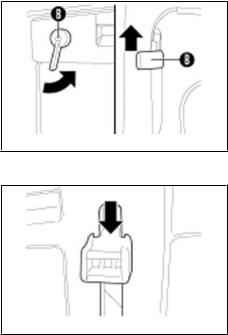
To open both doors from the inside, use the special release control «B».
For the handlebar version, the release control «B» must be lifted, while for the steering wheel version it must be pushed rightwards.
MAKE SURE IT IS SAFE TO OPEN THE DOORS BEFORE OPENING THEM. BEFORE STARTING OFF, MAKE SURE THE DOORS ARE CLOSED AND LOCKED. THIS PRECAUTION WILL ENSURE THEY DO NOT OPEN ACCIDENTALLY WHICH WOULD BE A HAZARD FOR THE DRIVER
04_03
Front door windows (04_04)
To open the windows, press the release lever while moving the handle downwards.
(7 fixed positions are available).
To close the windows, move the handle to "travel end top" position.
04_04
29
locks and Doors 4
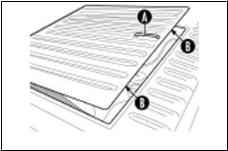
Engine inspection port (04_05)
Lower the rear side board and grip the handle «A» pulling it upwards to release the retain clips «B».
On the vehicles with loading body in light alloy with tilting, to access the engine compartment it is necessary to lower the side and rear boards and then tilt the loading body.
Use the special safety bar to secure the loading body in tilted position.
NEVER WORK UNDERNEATH THE LOADING BODY WHEN IT IS TILTED WITH- 04_05 OUT HAVING FIRST SECURED THE SAFETY BAR. DANGER OF SERIOUS IN-
JURY.
4 Doors and locks
30
